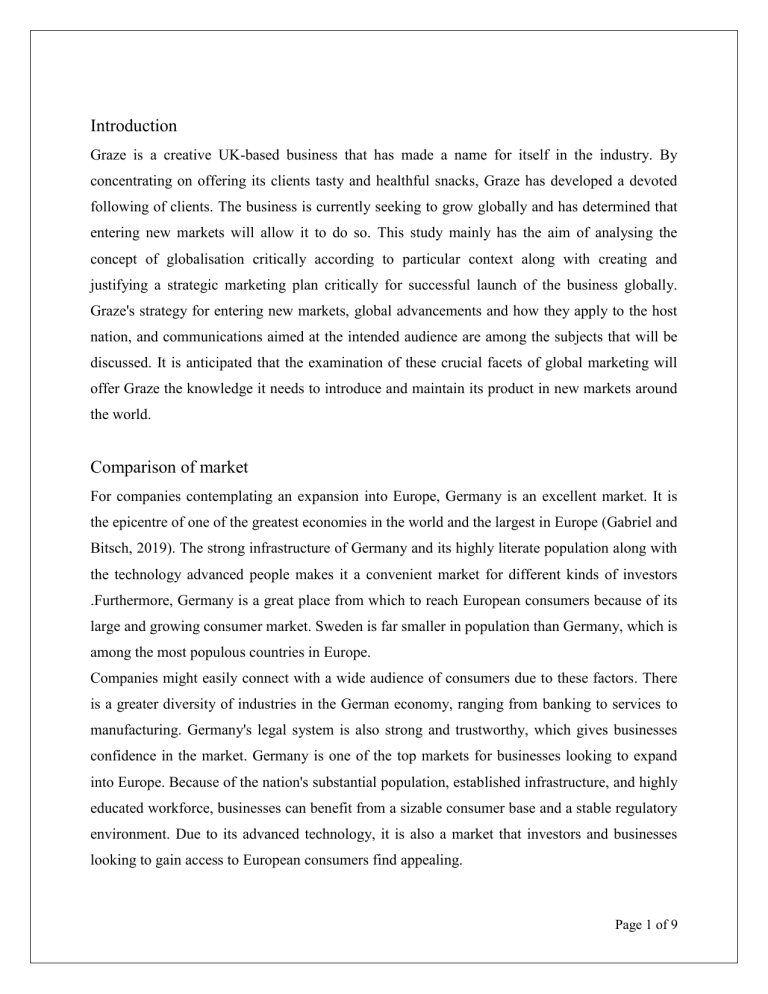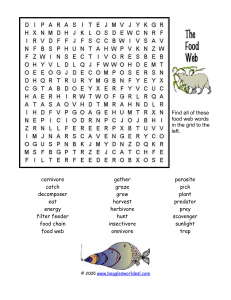
Introduction Graze is a creative UK-based business that has made a name for itself in the industry. By concentrating on offering its clients tasty and healthful snacks, Graze has developed a devoted following of clients. The business is currently seeking to grow globally and has determined that entering new markets will allow it to do so. This study mainly has the aim of analysing the concept of globalisation critically according to particular context along with creating and justifying a strategic marketing plan critically for successful launch of the business globally. Graze's strategy for entering new markets, global advancements and how they apply to the host nation, and communications aimed at the intended audience are among the subjects that will be discussed. It is anticipated that the examination of these crucial facets of global marketing will offer Graze the knowledge it needs to introduce and maintain its product in new markets around the world. Comparison of market For companies contemplating an expansion into Europe, Germany is an excellent market. It is the epicentre of one of the greatest economies in the world and the largest in Europe (Gabriel and Bitsch, 2019). The strong infrastructure of Germany and its highly literate population along with the technology advanced people makes it a convenient market for different kinds of investors .Furthermore, Germany is a great place from which to reach European consumers because of its large and growing consumer market. Sweden is far smaller in population than Germany, which is among the most populous countries in Europe. Companies might easily connect with a wide audience of consumers due to these factors. There is a greater diversity of industries in the German economy, ranging from banking to services to manufacturing. Germany's legal system is also strong and trustworthy, which gives businesses confidence in the market. Germany is one of the top markets for businesses looking to expand into Europe. Because of the nation's substantial population, established infrastructure, and highly educated workforce, businesses can benefit from a sizable consumer base and a stable regulatory environment. Due to its advanced technology, it is also a market that investors and businesses looking to gain access to European consumers find appealing. Page 1 of 9 1. Market Entry Strategy Grace is a company of British origin and it is a well-known entity. It mainly deals in manufacturing and proceeds with marketing food products such as snacks After experiencing recent success, the company is now aiming to grow into new markets. Making a decision for entering a brand new market is quite challenging. The possibility associated with making a direct agreement with a popular and large chain of supermarkets needs to be scrutinised carefully at the time of entering Germany (Friebel et al. 2022). Signing contracts directly with the leading chain of supermarkets in China gave proper rights for the company to sell its products in the physical stores. This plan has the benefit of giving Graze the exclusive right to sell in the chosen supermarkets' locations, giving them an edge over rival companies. The German retail and consumer landscape must be taken into account when determining whether this strategy is feasible. The food retail market of Germany is highly competitive and controlled through a number of large retailers in accordance with your monitor passport. Top 5 retailers of Germany contributed about 70% of the sales in the grocery industry for the year 2017 (Horoś and Ruppenthal, 2021). This implies that these retailers would be able to set prices and promotions and exert significant market control. Given that German consumers are notoriously finicky about prices, Graze products' ability to be affordable will be crucial to their success. Additionally local products are preferred typically by the consumers of Germany and the organisation may want to think about localisation of its offerings in order to maintain competitive advantage in the market of Germany effectively. Lastly the organisation will have the requirement of concentrating on differentiation of products in order to meet the competition in the retail market of Germany and game proper profitability. The advantages and limitations of direct arrangement or agreement with a major grocery chain of Germany can be taken into account by the organisation in order to gain success in this market. Positively, a direct agreement would provide Graze greater control over pricing, product placement, and other crucial areas while giving it access to a sizable consumer base. Additionally the supermarket chain needs to be well established and the organisation can gain advantage from the recognition of the supermarket chain and use its present suppliers along with maintaining proper relationships with its consumers. Page 2 of 9 2. Global Trends and Their Application in the Local Environment Trend 1: One of the popular trends on a global level is rising veganism and vegetarianism which is particularly important for the brand recognition of this organisation. The surge of vegans and vegetarians in Germany is quite notable over the previous and it has been reported that their numbers increased up to 20% (Neufingerl and Eilander, 2023). Given that Graze is ideally situated to benefit from the growing popularity of plant-based diets, this trend is particularly pertinent to them. For instance, Graze's selection of snack boxes that are vegan and vegetarian may be a desirable choice for this expanding demographic. There is proof that vegetarianism and veganism are becoming more popular in Germany. For instance, the German government declared in 2017 that it intended to expand the options available in public canteens for vegan and vegetarian diets. Furthermore, there seems to be a growing demand for plant-based options in Germany, as evidenced by the notable rise in vegan and vegetarian restaurants over the past few years (Weber and Schütte, 2019). It is suggested that Graze in Germany concentrate more on promoting their snack boxes that are vegan and vegetarian. Trend 2: The high desire for the food to be sustainable and organically is the second trained on world wide level that is specifically important for the brand preposition of the organisation. Considering the fact that Graze introduced different boxes of organic snacks recently this popular trend is quite important for them. In addition, Graze has vowed to use environmentally friendly packaging and partnered with the Rainforest Alliance, a nonprofit dedicated to preserving rainforests and advancing sustainable agriculture. There is proof that organic and sustainably produced food is becoming more and more popular in Germany (Gollnhofer et al. 2019). For instance, the farms of Germany dealing in organic products have experienced a growth in a dramatic way in the previous years and the Government of this country has been progressive in making large investments to support the agricultural methods that are environmentally friendly. Furthermore, sales of organic food have increased by 10% in the past year in Germany, indicating a significant increase in demand for organic food. Page 3 of 9 It is advised that the organisation in Germany mainly emphasises on promoting its snake boxes which are organic and quite sustainable. This can be accomplished through promoting the snack boxes on different social media platforms and expanding its presence in the physical stores dealing in organic and sustainable products (Bocken et al. 2020). Moreover the organisation needs to focus more on creating sustainable and organic options of snack boxes that will attract the attention of the consumers in Germany. Through this brand X can gain the ability to take advantage in the market. 3. Country-Specific Communications (i) Segmentation, Target, and Positioning (STP) strategy Segmentation In order to divide up the German market, Graze can employ a range of segmentation techniques, including behavioural, psychographic, demographic, and geographic. The market is segmented geographically to create distinct geographic divisions. The market can be segmented based on age, gender, income, and education levels using demographic segmentation. Market segmentation based on lifestyle, attitudes, and interests can be achieved through psychographic segmentation. Market segmentation based on usage and loyalty is achieved through behavioural segmentation (Bollweg et al. 2020). The target audience will be defined by the segmentation criteria of age (18–40), income (high to medium), and lifestyle (healthy). Target Segmentation techniques can be used by the organisations for identifying the target market of Germany for selling their products. The defined target market of Germany needs to include customers belonging to every age and gender having high incomes and who are always health conscious (Fernie, 2023). The target market for the organisation in the German market can be the millennials who are health conscious and the generation X who focuses on quality. Positioning Graze can effectively position its products in the minds of German consumers by highlighting their exceptional quality, distinctive product offerings, and health benefits. Additionally, Graze can market its goods as tasty, reasonably priced, and convenient snack options that work well for Page 4 of 9 any occasion. Graze can potentially penetrate the German market by leveraging its well-known brand in the UK. Graze plans to enter the market as a high-end snack supplier, providing easy-toeat, healthful snacks produced with premium ingredients. (ii) Briefly outline the marketing mix Product: Graze ought to concentrate on customising its offering for the German market. In order to ensure that the product appeals to German consumers, this may involve localising the product's packaging and content. Furthermore, it would be beneficial for Graze to conduct research on local preferences in order to determine whether any product range additions or modifications would better cater to the German market Price: Graze needs to make sure that their costs are reasonable and commensurate with the quality of the goods. In order to increase sales, the business should also think about providing discounts to its German clientele. Place: Graze should concentrate on reaching the right customers through the appropriate distribution channels. Using offline and online channels, like convenience stores and supermarkets, may fall under this category (Schrage and Rasche, 2022). Graze should also think about collaborating with nearby merchants in order to reach a larger audience. Promotion: Graze should use a range of marketing channels, including digital marketing, direct marketing, public relations, and advertising, to promote its products in the German market. Advertising is a useful tool for reaching a wide audience and can be used to inform and raise awareness of a product among consumers (Frei et al. 2020). This could involve print, radio, television, and social media advertising. Graze should also think about utilising influencer marketing. In addition to raising awareness, public relations can be a useful tool for cultivating connections with the German market. Direct marketing can be used to turn prospects into customers and is an efficient method of interacting with particular target audiences (Frank and Peschel, 2020). Lastly, using digital marketing to reach a large audience and interact with them personally is a great strategy. Page 5 of 9 (iii) Examine the extent to which social media communications need to be standardized or adapted The best method for connecting with your target audience is through social media. The successful launch of Graze in the German market depends on the standardization and modification of social media communications. Graze needs to modify its social media communications approach to better suit German culture and customer demands. According to Tolstoy et al. (2021), social media platforms like Facebook, Instagram, and YouTube need to adapt to the language and culture of Germany. For instance, Graze should make sure that their communications are brief and direct because German customers prefer this style of communication. Graze ought to leverage particular platforms that are more well-liked in Germany, like StudiVZ and Xing. Graze needs to make sure that they interact with German customers in a proper manner. This entails abiding by German traditions and customs, such as avoiding direct communication and acting professionally and politely when interacting with others. Additionally, Graze needs to make sure that the posted material is appropriate for the German market and speaks to the culture. Conclusion It can be concluded that if the organisation has proper knowledge about the detail environment and the consumer then they can enter the market of Germany in a successful manner and through making contact with the major chain of grocery in the country by signing direct agreement. In order to proceed with creation of segmentation targeting and positioning process for the local environment in the Germany it is important for identifying the two major trains of global level that are important for the brand proposition of brand X. Moreover the company needs to apply successful combination of the marketing platform such as the social media platform which are customised according to the demands and nature of the regional consumers. It can make it possible for the organisation to effectively inform interact with and attract attention of the German customers. Page 6 of 9 References Bocken, N., Morales, L.S. and Lehner, M., 2020. Sufficiency business strategies in the food industry—The case of Oatly. Sustainability, 12(3), p.824. https://www.mdpi.com/20711050/12/3/824/pdf Bollweg, L., Lackes, R., Siepermann, M. and Weber, P., 2020. Drivers and barriers of the digitalization of local owner operated retail outlets. Journal of Small Business & Entrepreneurship, 32(2), pp.173-201. https://www.researchgate.net/profile/Lars- Bollweg/publication/333519834_Drivers_and_barriers_of_the_digitalization_of_local_owner_o perated_retail_outlets/links/5cf3bbe1a6fdcc8475fdfc9b/Drivers-and-barriers-of-thedigitalization-of-local-owner-operated-retail-outlets.pdf Fernie, J., 2023. The internationalization of the retail supply chain. In Logistics And Retail Management insights Into Current Practice And Trends From Leading Experts (pp. 47-65). CRC Press. https://www.ghasemiran.org/upload/upload/1690874712-Logistics-and-Retail- Management-Emerging-Issues-and-New-Challenges-in-the-Retail-Supply-Chain,-3rd-Edition(John-Fernie,-Leigh-Sparks)-(Z-Library).pdf#page=84 Frank, D.A. and Peschel, A.O., 2020. Sweetening the deal: The ingredients that drive consumer adoption of online grocery shopping. Journal of Food Products Marketing, 26(8), pp.535-544. https://www.tandfonline.com/doi/pdf/10.1080/10454446.2020.1829523 Frei, R., Jack, L. and Krzyzaniak, S.A., 2020. Sustainable reverse supply chains and circular economy in multichannel retail returns. Business Strategy and the Environment, 29(5), pp.19251940. https://researchportal.port.ac.uk/files/18627095/JACK_2020_cright_BSE_Sustainable_Reverse_ Supply_Chains_and_Circular_Economy_in_Multichannel_Retail_Returns.pdf Friebel, G., Heinz, M. and Zubanov, N., 2022. Middle managers, personnel turnover, and performance: A long‐term field experiment in a retail chain. Management Science, 68(1), pp.211-229. https://kops.uni-konstanz.de/bitstreams/249b8bf6-66bb-44bf-8828- 3b90657fb424/download Page 7 of 9 Gabriel, A. and Bitsch, V., 2019. Impacts of succession in family business: A systemic approach for understanding dynamic effects in horticultural retail companies in Germany. Journal of Small Business and Enterprise Development, 26(3), pp.304-324. https://www.emerald.com/insight/content/doi/10.1108/JSBED-01-2018-0030/full/html Gollnhofer, J.F., Weijo, H.A. and Schouten, J.W., 2019. Consumer movements and value regimes: Fighting food waste in Germany by building alternative object pathways. Journal of Consumer Research, 46(3), pp.460-482. https://research.aalto.fi/files/56883181/GOLLNHOFER_ConsumerMovementsAndValueRegime s_final_alexandria.pdf Horoś, I.K. and Ruppenthal, T., 2021. Avoidance of food waste from a grocery retail store owner’s perspective. Sustainability, 13(2), p.550. https://www.mdpi.com/2071- 1050/13/2/550/pdf Neufingerl, N. and Eilander, A., 2023. Nutrient Intake and Status in Children and Adolescents Consuming Plant-Based Diets Compared to Meat-Eaters: A Systematic Review. Nutrients, 15(20), p.4341. https://www.mdpi.com/2072-6643/15/20/4341 Schrage, S. and Rasche, A., 2022. Inter-organizational paradox management: How national business systems affect responses to paradox along a global value chain. Organization studies, 43(4), pp.547-571. https://tore.tuhh.de/bitstream/11420/12203/1/10.1177_0170840621993238.pdf Tolstoy, D., Nordman, E.R., Hånell, S.M. and Özbek, N., 2021. The development of international e-commerce in retail SMEs: An effectuation perspective. Journal of World Business, 56(3), p.101165. https://www.sciencedirect.com/science/article/pii/S1090951620300936 Weber, F.D. and Schütte, R., 2019. State-of-the-art and adoption of artificial intelligence in retailing. Digital Policy, Regulation and Governance, 21(3), pp.264-279. https://www.researchgate.net/profile/Felix-Weber-12/publication/333222953_State-of-theart_and_adoption_of_artificial_intelligence_in_retailing/links/5d42a8df299bf1995b5b8fd5/State -of-the-art-and-adoption-of-artificial-intelligence-inPage 8 of 9 retailing.pdf?_sg%5B0%5D=started_experiment_milestone&origin=journalDetail&_rtd=e30%3 D Page 9 of 9




